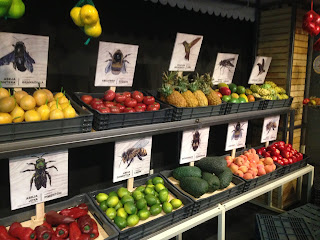 |
| A honey bee captured having a feast on a Calliandra trinerva inflorescence |
I have been thinking about this for several weeks now. Although I feel writing is something I should be doing in Spanish (both because its easier for me and it´s a thousand times less terrible for my readers to understand) I have pushed the door, and decided to give English a go in this space. Curiosity is killing me, I am very anxious to see if more people will start reading me, or if current followers will walk away. The funny thing is I started this blog as an informative space; something were I had the chance of studying common interests around food and generating discussions with whoever was interested in it. Anyhow, along the four years since I started, it transformed into a way of listening to myself, almost a self-inducted psychological therapy. So I still write for an audience, but that is probably only an excuse for me to have fun around food.
 |
| Beautifully decorated with food related implements, my favorite part of the exposition was the showcase of different corn varieties existing in South America in pre-Spanish times. Unfortunately this diversity (probably thousands of varieties) has been wiped out by the convenience of more homogeneous, easy to reproduce, harvest, transport, store and manufacture varieties. |
I left Colombia a couple of weeks ago, and I have officially started a new project in my academic life: pollination in urban contexts. This new project is, off course, a consequence of my previous research experience and interests, both as a biologist and as a resource economist. Anyhow, food production and urbanization were not really present in my research, although they controlled an extremely relevant part of my brain. That is why I decided to put all my passions into a blender and that is how I came up with this exceptionally interesting research topic. I have found myself running around the globe, following ideas of others, trying to understand how things work from Bogotá to Hong Kong, from Santiago to Auroville. I feel like the Red Queen, when asked by Alice in Carroll´s Through The Looking Glass why is she running so fast all the time, and she replies: "Now, here, you see, it takes all the running you can do, to keep in the same place".
 |
| The common honey bee will visit 4´000,000 flowers in order to produce one kg of honey; the distance those bees traveled for that kilo is equivalent to the perimeter of Earth |
Pollination has become a large preoccupation for farmers, politicians and scientists around the world. As an introduction to some of the issues around pollinators, I invite you to see Professor´s Dave Goulson (believe me, an expert)
talk on bees, pesticides and politics. Apart from prof. Goulson´s, there are hundreds of videos, articles and expositions around the world, broadcasting the huge issues around pollination, food production and biodiversity conservation. Although this sounds preoccupying, I actually feel good every time I see all this information been made readily available for everyone, jumping out of labs, research stations and academic journals into people´s TVs, radios and YouTube channels. Here is another bit of information on ecosystem services, for those who are still not quite in touch with the concept:
How People Benefit From Nature, by Rebecca L. Goldman
 |
| An amazing experience for people who are not familiarized with live sciences, this shows hoy different animals (they have even included hummingbird-pollinated fruits!) work hard daily to help transform beautiful flowers into nutritious food... How amazing can flowers and pollinators be? |
I want to close this small introductory chapter into pollination ecology with something very moving that was going on in Medellín, Colombia just before I came to Australia.
Parque Explora, a fantastic interactive museum which I highly recommend to everyone who is visiting Medellín, was holding a terribly good exposition on food. As you might be able to see in the pictures, the exposition focuses on Latin American food, the way it is produced and the whole array of environmental, politic, economic and social consequences of producing food. These topics might seem pretty obvious for most of you, but watching how visitors reacted to the information was amazing. Standing there, we were able to see how kids had the (frightening) idea that food came from the supermarket, and adults ignored the fact that fruits came from flowers, only after these had been pollinated.
Awareness is the first step for change. I guess the second one is education, and the third one action. Ecosystem services are becoming a popular topic, especially pollination. I hope the research I am going to be doing in the following couple of years contributes a little bit on those three steps, I will keep running as fast as I can, I promise!






Comments
Post a Comment